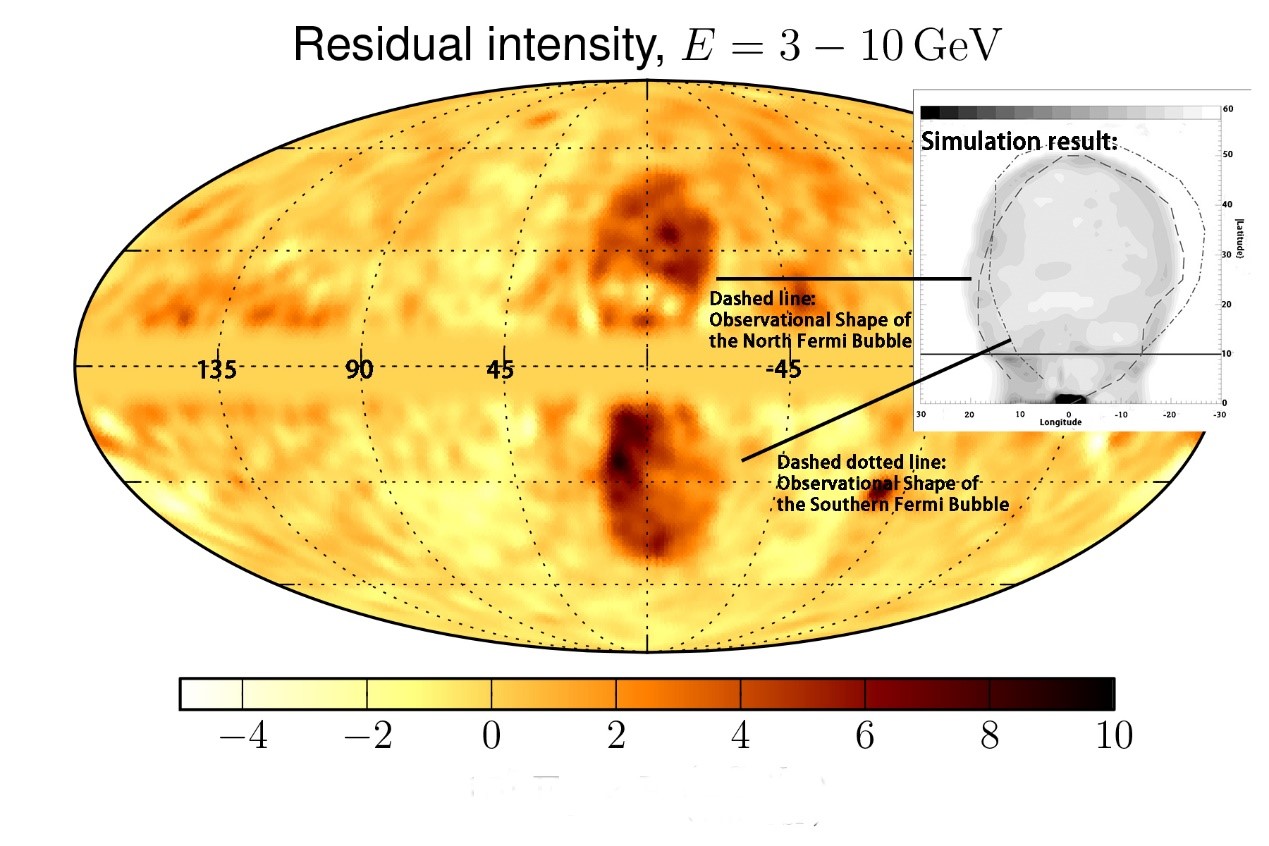Two giant gamma-ray bubbles above and below the Galactic plane were discovered by the Fermi Gamma-ray Space Telescope on 2010. How did the called Fermi bubbles form? How can we explain their observational characteristics, such as their morphology, distribution of surface brightness and so on? In the last years, astronomers from Shanghai Astronomical Observatory have built a hot accretion wind model, which can successfully explain the morphology. Recently, their new study shows that their model can well explain the observed radiation properties of the Fermi Bubbles. This work has been accepted by the Astrophysics Journal.
What’s the Fermi bubbles in the Milky Way? Why are astronomers fond of them?
In 2010, two giant gamma-ray bubbles above and below the Galactic plane were discovered by the Fermi Gamma-ray Space Telescope, thus they are called the Fermi bubbles. The bubbles extend to ~50 degree above and below the Galactic plane, and the width is ~40 degree in longitude.
“This important discovery implied the activity of the Galactic center in the past. Through the investigation of the Fermi bubble formation, a timescale constraint can be placed in the activity of the Galactic center in the past millions or tens of millions of years. The origin of the gamma rays, is an important observational constraint for understanding questions about acceleration of high energy particles in the Milky Way, and even for investigation of dark matter.” Said Dr. Guobin Mou (Supervisor: Prof. Feng Yuan), the first author of this newest progress.
How did the Fermi bubbles form?
Several models have been proposed to explain the formation of the Fermi bubbles. In terms of the origin of gamma-ray photons of the Fermi bubbles, there are three theoretical models: the leptonic model, the hadronic model and the dark matter annihilation model. In the leptonic model, the gamma-ray photons come from the interaction (the inverse Compton scattering mechanism) of soft photons in the Galactic halo with the high energy electrons. While in the hadronic model, the gamma-ray photons are produced by the decays of neutral pions produced by the collisions between cosmic ray protons and thermal nuclei of the Interstellar Medium. In terms of dynamics, there are several models including the jet model, the radiation driven wind model, the star formation driven wind model and so on.”
What has SHAO researched on the Fermi bubbles?
“In our model, the formation of the Fermi bubbles can be due to the interaction between winds launched from the hot accretion flow in the Galactic center and the interstellar medium.” Prof. Yuan from SHAO said, “There are two advantages of this ‘accretion wind’ model. One is that, with strong physical foundations, the parameters of the winds are taken from the small scale numerical simulation. The other is that the power of the wind in our model is consistent with independent observational evidences.”
Prof. Yuan started his study of hot accretion flow from the early beginning of this field. In the past fifteen years, he and his collaborators have written many influential papers and made creative contributions. These include the discovery of a new hot accretion solution, the radiatively-inefficient accretion flow model for the supermassive black hole in the Galactic center, the MHD (Magnetohydrodynamic) model for the formation of episodic jet, the proof of the existence of significant wind from hot accretion flow, and various applications of the hot accretion flow theory in AGNs and black hole X-ray binaries.
Especially for the explanation of the Fermi bubbles, Dr. Mou said, “according to our simulations, we found that the Fermi bubbles began to form about ten million years ago, which indicates that the Galactic center was in a hot accretion flow mode in the past. What’s more, our work suggests that the hadronic model can well explain the morphology and the spectral energy distribution. It also explains other features, such as the uniform surface brightness and the boundary width of the bubbles.”

This figure shows that the simulation result from the hadronic model can well explain the observed morphology of the Fermi Bubbles.
Research paper online can be referred here:
http://arxiv.org/abs/1505.00892 for the newest progress
http://adsabs.harvard.edu/abs/2014ApJ...790..109M for the previous work in this series.
More references can be checked here:
http://www.shao.ac.cn/xwzx/kydt/201409/t20140913_4202991.html
Science contact: Guobin Mou, gbmou@shao.ac.cn Feng Yuan, fyuan@shao.ac.cn
News contact: Wenwen Zuo, wenwenzuo@shao.ac.cn, 021-34775125